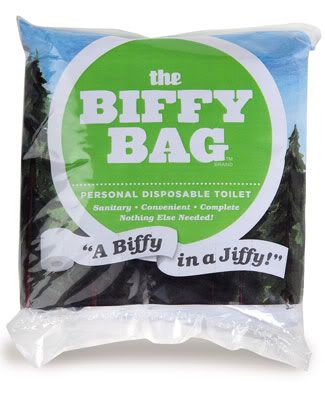
Dear Education Department,
I just went canyoneering for the first time a couple weeks ago. While we were in there, we were wondering just how exactly one goes to the bathroom in a canyon. Is there any other answer besides a WAG Bag or Restop? It might sound lazy that I don't want to carry it out, but it would be great to know all of our options.
Sincerely, Grossed Out
------------------------------------------------------------------------------
Dear Grossed Out,
First, we always recommend adhering to the land manager’s rules and regulations, particularly those pertaining to disposal of human waste in sensitive environments such as desert canyons. We also encourage recreationists to always consider using the lowest impact practices possible when enjoying the out of doors.
I know that the idea of packing out your human waste can be fairly (to completely) unpalatable, but there is no doubt that it leaves the least impact of any other method of disposing human waste. Both Clean Waste Kits (formerly WAG Bag): http://www.cleanwaste.com/, Biffy Bags: http://www.biffybag.com/ and Restops: http://www.whennaturecalls.com/are all very sanitary options for packing out your human waste.
I personally use a bag type system on river trips in the arid west where allowed, and have found them to be a great product for dealing with what could be a very unpleasant proposition. I’d encourage to you give some thought to the impact that you leave behind, which will undoubtedly impact other people, water, wildlife or all of the above. If you really enjoyed the place you went canyoneering, and you like the thought of it staying in the same (or better) condition as when you first visited, think about how you can minimize your individual impact the next time you venture out.
Our general guidance for proper human waste disposal in any environment is as follows –
Proper human waste disposal will allow you to:
- Avoid polluting water sources
- Eliminate contact with insects and animals
- Maximize decomposition
- Minimize the chances of social impacts
Improper disposal of human waste can lead to water pollution, the spread of illnesses such as giardia, and unpleasant experiences for those who follow.
Facilities/outhouses. Whenever possible, take time to locate and use bathrooms, outhouses, and other developed sites for human waste disposal.
Cat holes. If no facilities are available, deposit solid human waste in cat holes dug 6 to 8 inches deep at least 200 feet from water, camp,trails, and drainages. Look for organic soil under trees and away from cryptobiotic soil crusts for your cat hole site. Bring a trowel to dig the hole, and disguise it well before leaving. Ideally, the microbes found in soil break down feces and the pathogens they contain, but in the desert, this process happens very slowly, so make sure your cat hole site is well-hidden and buried deeply so it won’t be uncovered accidentally. Don’t leave human waste under rocks or in alcoves because it will decompose slowly there. If the cat hole method is ill suited to your group, it’s best to camp where an outhouse or pit toilet is available. Good cat hole sites isolate waste from water sources such as lakes, streams, dry creek beds, ravines, potholes, and other visitors. Whenever possible, use a remote location during the day’s hike to help prevent a high concentrations of cat holes near campsites.
Toilet paper. Plan ahead to pack out used toilet paper in a plastic bag. This practice leaves the least impact on the area. Packing soiled toilet paper with baby wipes deodorizes the trash bag, and the wipes help you stay cleaner. Double bagging your trash prevents any accidental contamination. Burying toilet paper in the desert is not recommended. The arid environment preserves paper—newspapers from the 1870s that were used to insulate mining cabins in the desert are still legible today. Burning toilet paper at the site is also not recommended both because it is hard to burn the paper completely and because the practice has caused wildfires. Natural toilet paper such as grass, river rocks, sticks, and snow can be surprisingly effective. If you choose to use natural toilet paper, bury it in your cat hole. Always pack out feminine hygiene products because they decompose slowly and attract animals. If you do not believe your group is capable of packing out toilet paper hygienically, your only option may be to instruct everyone to bury it in their cat holes. If you choose this option, be particularly diligent about digging down deeply enough to prevent scavenging animals from excavating the contents.
Carrying waste out. Often, visitor use is high and soils sparse in desert areas. Recreation managers seeking to protect human health and water sources employ a spectrum of toilet designs and approaches to managing human waste—even airlifting such waste out with helicopters. There are a number of products available now for packing out your own feces. One effective, low-cost option is to carry and use a homemade poop tube or to purchase a device designed specifically for transporting human waste. Some of these products allow you to dispose of human waste in landfills or trash cans, others need to be deposited in pit toilets or porta-johns. Check with local land managers or the Leave No Trace Center for Outdoor Ethics for information about these products and other appropriate disposal techniques for human waste.




1 comment:
Good information!
Post a Comment